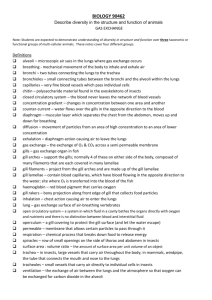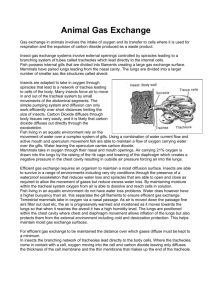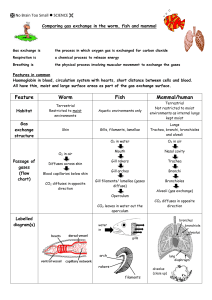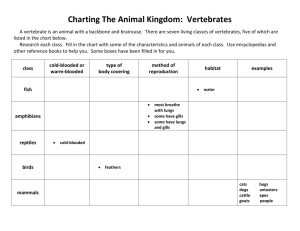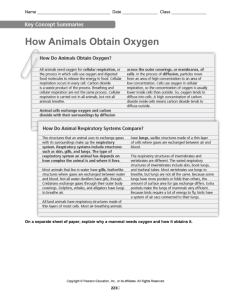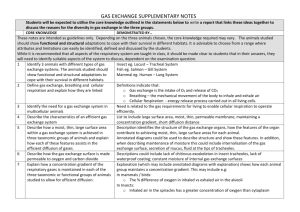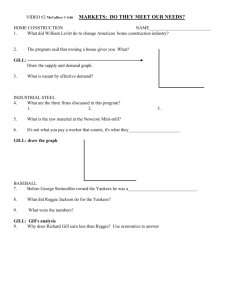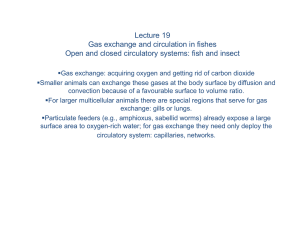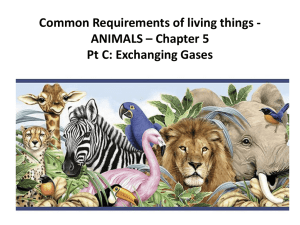biology 90462 - No Brain Too Small
advertisement
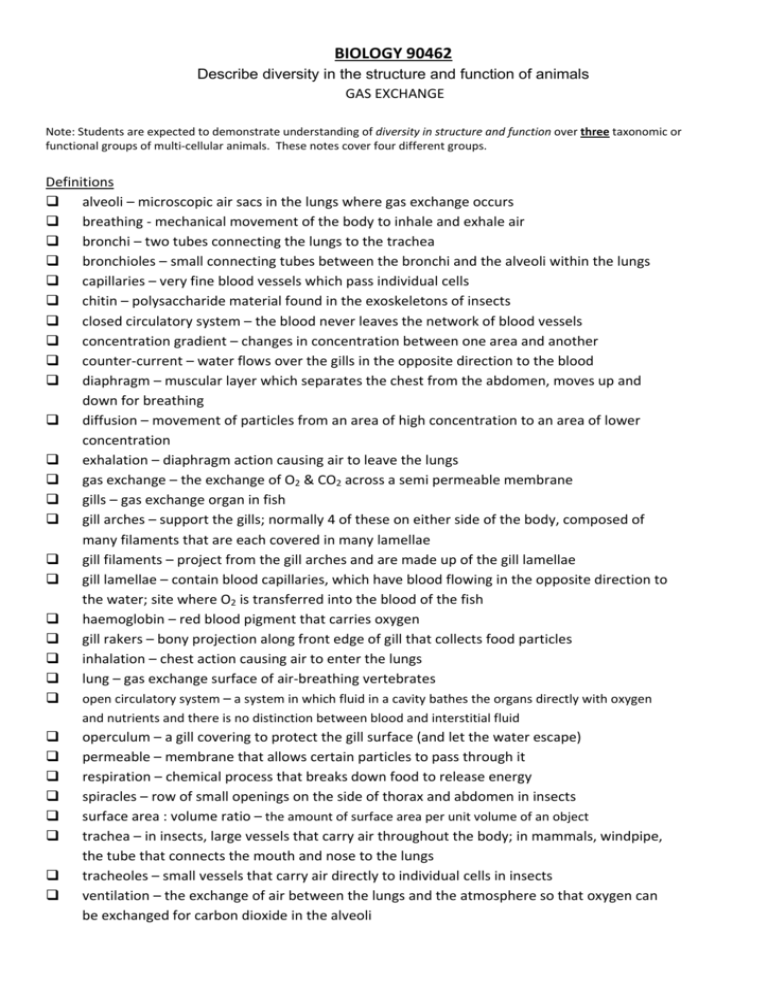
BIOLOGY 90462 Describe diversity in the structure and function of animals GAS EXCHANGE Note: Students are expected to demonstrate understanding of diversity in structure and function over three taxonomic or functional groups of multi‐cellular animals. These notes cover four different groups. Definitions alveoli – microscopic air sacs in the lungs where gas exchange occurs breathing ‐ mechanical movement of the body to inhale and exhale air bronchi – two tubes connecting the lungs to the trachea bronchioles – small connecting tubes between the bronchi and the alveoli within the lungs capillaries – very fine blood vessels which pass individual cells chitin – polysaccharide material found in the exoskeletons of insects closed circulatory system – the blood never leaves the network of blood vessels concentration gradient – changes in concentration between one area and another counter‐current – water flows over the gills in the opposite direction to the blood diaphragm – muscular layer which separates the chest from the abdomen, moves up and down for breathing diffusion – movement of particles from an area of high concentration to an area of lower concentration exhalation – diaphragm action causing air to leave the lungs gas exchange – the exchange of O2 & CO2 across a semi permeable membrane gills – gas exchange organ in fish gill arches – support the gills; normally 4 of these on either side of the body, composed of many filaments that are each covered in many lamellae gill filaments – project from the gill arches and are made up of the gill lamellae gill lamellae – contain blood capillaries, which have blood flowing in the opposite direction to the water; site where O2 is transferred into the blood of the fish haemoglobin – red blood pigment that carries oxygen gill rakers – bony projection along front edge of gill that collects food particles inhalation – chest action causing air to enter the lungs lung – gas exchange surface of air‐breathing vertebrates open circulatory system – a system in which fluid in a cavity bathes the organs directly with oxygen and nutrients and there is no distinction between blood and interstitial fluid operculum – a gill covering to protect the gill surface (and let the water escape) permeable – membrane that allows certain particles to pass through it respiration – chemical process that breaks down food to release energy spiracles – row of small openings on the side of thorax and abdomen in insects surface area : volume ratio – the amount of surface area per unit volume of an object trachea – in insects, large vessels that carry air throughout the body; in mammals, windpipe, the tube that connects the mouth and nose to the lungs tracheoles – small vessels that carry air directly to individual cells in insects ventilation – the exchange of air between the lungs and the atmosphere so that oxygen can be exchanged for carbon dioxide in the alveoli All animals must exchange gases with environment to carry out respiration gas exchange ‐ the intake of O2 and release of CO2 breathing ‐ the mechanical movement of the body to inhale and exhale air cellular respiration ‐ energy release process carried out in the mitochondria of all living cells Key Ideas Raw materials are available from different mediums, oxygen from air (mammals, insects, worm) or water (fish). Challenge of different environments and metabolic requirements. Animal groups show diversity to solve requirements for metabolism and size, and because of the medium they live in. Characteristics of an efficient gas exchange system large surface area permeable membrane moist maintaining a concentration gradient thin short diffusion distance INSECTS diffusion is adequate for small invertebrates e.g. worms, while others such as insects required a tracheal system as they have higher energy requirements; gases need to be transported directly to the respiring tissues open circulatory system tracheal system o tiny holes called spiracles along the side of the insect have the ability to open and close spiracles; spiracles can be closed by valves and may be surrounded by tiny hairs that help keep humidity around the opening, to ensure there is a lower concentration gradient main trachea of water vapour, and so less is lost from the insect by evaporation o o o o o inhaled air in the spiracles has a greater concentration of oxygen than cytoplasm therefore the O2 freely diffuses into the cytoplasm chitin is present to prevent collapsing of trachea fluid at the tops of tracheoles in which the gases are dissolved wide distribution of tracheoles through insect tissues wing movement to optimise air uptake spiracles finely branched tracheae (tracheoles) FISH gills o gills protected by operculum o movement of water through mouth and across gill surfaces o filament structure; filaments have many protrusions called gill lamellae. The folds are kept supported and moist by the water that is continually pumped through the mouth and over the gills, if water is absent the gills collapse greatly reducing there efficiency o numerous folds to gill structure – increasing surface area so more efficient gas exchange o fish need to constantly gulp water, they often swim upstream to maintain a constant flow of water closed circulatory system more difficult for fish to get the required amount of O2 from the water compared with mammals because the concentration of dissolved oxygen in water is less than 1% % difference of dissolved oxygen in surrounding water compared to the dissolved oxygen in the blood. o use of the counter current flow to maintain efficient gas exchange in fish; water flowing past the gills in the opposite direction to the blood water water blood blood If flowing the same way only 50% of O2 in the water can be exchanged If counter current (water and blood flowing in opposite directions) 85% of O2 in the water can be exchanged dissolved gases diffuse faster between fluids with a large difference in gas concentration as the blood flows in the opposite direction to the water, blood is continually meeting fresh water with a higher percentage saturation of oxygen ‐ the concentration gradient is maintained across the gill lamella and oxygen continues to diffuse into the blood o efficient –fish extract 80% of the O2 from the 1% of the O2 dissolved in water o for a fish, tracheal system would be too heavy, while lungs would require vast amounts of water to extract sufficient oxygen MAMMALS lung system / diaphragm; lungs provide large, moist surface area for gas exchange closed circulatory system lungs are internal; internal gas exchange system reduces water loss by evaporation gas exchange surface of a mammal is the alveolus, which are grapelike structures at the ends of the bronchiole and are surrounded by blood capillaries trachea connected to the outside by the mouth and nose, splitting into two bronchi ‐ one for each lung ‐ and numerous bronchioles, supply the numerous alveoli ‐ air sacs – with gases o o air is moistened as it passes through the mouth and nose; gases will not diffuse unless they are dissolved in water diaphragm relaxes reducing the pressure inside the lungs, drawing the gases into the body while when the diaphragm contracts it increases the pressure inside the lungs pushing the air out of the body the concentration gradient of the respiratory gases is maintained because o blood supply is extensive, which means that oxygen is carried away to the cells as soon as it has diffused into the blood. o ventilation movements maintain the concentration gradients because air is regularly moving in and out of the lungs o the % difference of oxygen in inhaled vs exhaled air in the alveoli helps maintain the concentration gradient shape of alveoli to maximise surface area; massive surface area through which gases can diffuse warming and cleaning of the air as it comes through the nose in order to minimise alveoli damage and improve rate of diffusion WORMS external gas exchange system skin provides large, moist surface area compared with body size for gas exchange due to being long and thin gas exchange surface of a worms is their skin open circulatory system skin is kept moist by the mucus glands below the skins surface secreting a moistening fluid onto the skin worms only live in damp areas and are nocturnal so their skin doesn’t dry out and gas exchange stop if soil too wet will come to surface otherwise they drow; if soil too dry will burrow deeper to where the soil is moist worms are often red in colour due to the network of blood vessels just below the skins surface the distance gases must diffuse is very short Main capillary Worms can use their skin for gas exchange although they are quite ‘large’ because they have o a low metabolic rate and don’t require large amounts Hearts of O2 o a moist surface with large network of blood vessels in skin allows for very efficient gas exchange between air and blood o worms circulatory system contains haemoglobin in Ventral vessel Capillary the blood o the long, thin body shape increases the surface area for gas exchange o the blood vessels are very close to the surface creating a very short diffusion distance Diagrams may be used in your response, but they must be clearly labelled.
